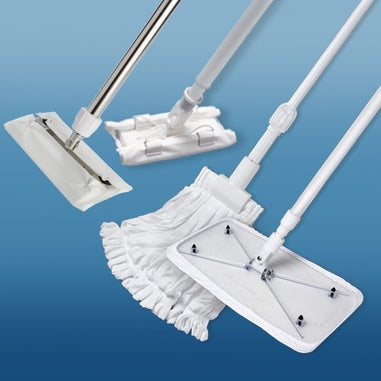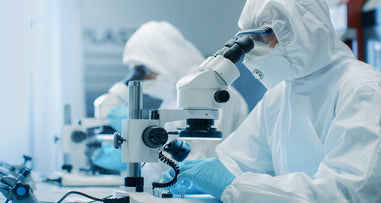- No products in the cart.
For any research lab, establishing the cleanroom is an important aspect of the manufacturing and developing process. Cleanrooms need to have a maintained and controlled environment to ensure the purity of research subjects. Based on this factor, there are different levels of cleanroom classification. Airborne particles and pollutants in this room are kept at a minimum and at a specified level. Once you understand cleanroom classifications and how they impact your research lab, you will be better able to choose the right laboratory products and implement industry best practices
Description: Scientist working in a Cleanroom environment
Lab Pro Cleanroom Supplies
To keep the air clean and free of particles, cleanrooms function on a positive air pressure method. High power HEPA filters pump air to remove contaminants from it. The air is pushed through the room and down towards the floor into the vents. This creates an air flow, which constantly cleans the contaminated air, pushes it away, and also constantly cleans the room. Apart from this, the cleanroom classification is another aspect which makes a pronounced difference on the end product. This classification hinges on different factors; the most important relates to the nature of your industry. To help you understand more about cleanroom classifications and their impact on your research lab, we have taken the time to outline the following:
Does The Nature of the Cleanroom Matter?
Cleanroom classification hinges a lot around the application of the room itself. This also affects how it works. To keep the air clean and free of particles, cleanrooms function on a positive air pressure method. High power HEPA filters pump air to remove contaminants from it. Positive pressure cleanrooms are common for many industries but not for all of them. In some industries such as in the medical field where they’re dealing with infectious diseases or hazardous substances, negative pressure cleanrooms might be used. Some industries are also stricter in the enforcement and application of cleanroom classifications and specifications. Being negligent here is dangerous as it increases the risk of product contamination. You can also face heavy fines or penalties for any oversight.
How to read Cleanroom Classifications:
Cleanroom standards are classified according to the number and size of particles permitted per volume of air in a specific amount of time.Clean room industry requirements are classified according to ISO 14644-5:2004 which specifies basic requirements for cleanroom operations. Federal Standard 209E is still also used (see Table 1).ISO cleanroom classifications are rated according to how much particulate of specific sizes exist per cubic meter (see second chart). The "cleanest" cleanroom is a class 1 and the "dirtiest" a class 9. Each clean room is rated by ISO class. This cleanroom standard rating system provides the necessary information to make an informed decision based on your product needs. Most clean rooms fall into the class 6,7, or 8 categories. Based on the number of contaminants which exist in the room, the contamination is measured. This is usually done on a per cubic meter ratio. Suppose you have a cleanroom classification of ISO Class 6 level and a rating of 35,200 per cubic meter. This means that you’re not allowed to exceed 35,200 and 0.5 microns in the cleanroom.
Why is the ISO Standard Preferred over the Federal Standard?
The ISO 14664-1 applies different classes, starting from class 1 as the cleanest and going up to class 9. As a rule of thumb, the lower the rating is on the ISO scale, the cleaner the room. Some businesses still make use of the Federal Standard 209E, but the ISO 14664-1 adds more classes to accommodate major areas, which were left out previously.
Here’s a table which sheds more light on the difference in their ratings:
|
||||||||||||||||||||||||||||||||||||||||||||||||||||||||||||||||||||||||||||||||||||||||||||||
| (µm denotes micron particle size) | ||||||||||||||||||||||||||||||||||||||||||||||||||||||||||||||||||||||||||||||||||||||||||||||
ISO Class 1
The “cleanest” cleanroom is ISO 1, used in industries such as life sciences and electronics that require nanotechnology or ultra-fine particulate processing. The recommended air changes per hour for an ISO class 1 clean room is 500-750, and the ceiling coverage should be 80–100%.
ISO Class 2
The recommended clean room air changes per hour for an ISO class 2 rated cleanroom is 500-700, with a ceiling coverage of 80-100%.
ISO Class 3
The recommended clean room air changes per hour for an ISO class 2 rated cleanroom is 500-750, with a ceiling coverage of 60-100%.
ISO Class 4
The recommended clean room air changes per hour for an ISO class 2 rated cleanroom is 400-750, with a ceiling coverage of 50-90%.
ISO Class 5
The recommended clean room air changes per hour for an ISO class 2 rated cleanroom is 240-600, with a ceiling coverage of 35-70%.













































